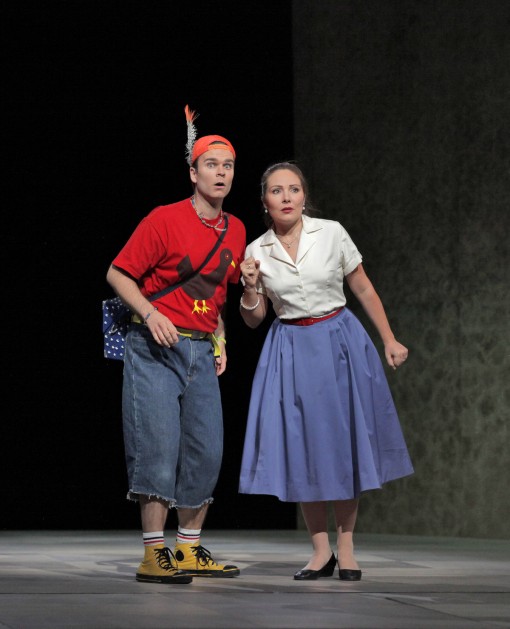Magnificent singing tops minimal staging in Santa Fe’s delightful “Magic Flute”

Joshua Hopkins as Papageno and Ekaterina Siurina as Pamina in Santa Fe Opera's "Magic Flute." Photo: Ken Howard.
Along with Richard Strauss and American works, Mozart has long been a supreme element at Santa Fe Opera. The company seems to have a knack for fielding inspired casts of up-and-coming singers that work well together and strike sparks in even the most familiar Mozart repertoire.
The company’s revival of The Magic Flute, heard Monday night, was in the same storied tradition. While one can quibble about the scenic design—what there was of it—-the young cast was terrific with a notable company debut.
It’s fortunate that the cast brought some youthful energy and charm because Tobias Hoheisel’s aggressively stark set had little of either, apart from the opening scene’s serpent with Tamino trapped in its jaws (the giant snake’s eyes close on cue when it is dispatched by the Three Ladies). The uber-Minimalist set consisted of just two bare walls, one curved and one flat, and zero stagecraft. The Queen of the Night simply walks on, the beasts charmed by Tamino’s flute are large cutouts of a lion, tiger, and crocodile rolled onstage, and the trials by fire and water are done with red and blue lighting. With the dour visuals, when the massive stage floor rises to become a brown back wall in Act 2 it seemed like the parting of the Red Sea.
The free-wheeling costumes and quirky elements helped provide more color and vitality with Papageno clad in baseball cap and red T-shirt with a bird picture, and the Three Boys with heads shaved as orange-clad Buddhist initiates. With the production’s built-in limitations, director Tim Albery made effective use of the side stairs for exits and entrances. Dialogue was presented in freely translated English vernacular and the music sung in German.
Ekaterina Siurina made a spectacular company debut as Pamina. The Siberian soprano’s voice is so well suited to the heroine’s music that Mozart could have written it with her in mind. Rarely will one experience such a wedding of voice to character, with Siurina’s purity of tone and gleaming vocalism spoiling audience members for all future Magic Flute productions. The soprano rose to the challenge of Ach, ich fuhls in remarkable fashion, singing this tortuous aria with refined expression and ravishing pianissimos, earning her an ovation that nearly stopped the show. Her charming Russian-accented English dialogue was irresistible as well.
Charles Castronovo has the apt noble bearing as the prince Tamino. His instrument, a classic lyric Mozart tenor with muscle—was heard to fine advantage in an ardent, sensitively sung Dies Bildnis.
Reprising his role from 2006, Joshua Hopkins was a wonderful Papapageno, singing with a fine baritone and making every punch line register, with the Canadian singer employing a fitful Texas accent.
Audrey Elizabeth Luna, taking over the role of the Queen of the Night from Erin Morley for the final three performances, seemed to have some initial nerves with a solid but cautious O zittre nicht. The soprano rebounded in Act 2 with an impressive Der Holle Rache, the stratospheric coloratura thrown off with more security and great panache.
Also back from 2006 was Andrea Silvestrelli as Sarastro. The Italian’s once-sonorous bass has frayed and is now decidedly worn around the edges. Still, he brought an individual touch and world-weary dignity to the role. It was great fun to experience his heavy accent in the English dialogue and have the usual dignified and reserved Sarastro morph into a passionate, gesturing Italian.
Timothy Oliver was a hoot in the quasi-Nazi getup as the villain Monostatos, seemingly inspired by Ronald Lacey’s SS officer in Raiders of the Lost Ark. Dale Travis was a first-rate Speaker, Jamie-Rose Guarrine, an unevenly projected Papagena.
Even by the generous latitude allowed for the boys singing the Three Spirits (Sean Jahner, Trent Llewellyn, and Craig Short), the vocalism was pretty grim. There was less excuse for the amusing but indifferently sung Three Ladies (Rachel Willis-Sorenson, Audrey Walstrom and Renee Tatum).
Conductor Lawrence Renes’ tempos were on the stately side in rather retro fashion, but he proved a reliable hand in the pit, accompanying the singers alertly and making all the big moments register.
Santa Fe Opera’s The Magic Flute has two more performances August 23 and 27. www.santafeopera.org.